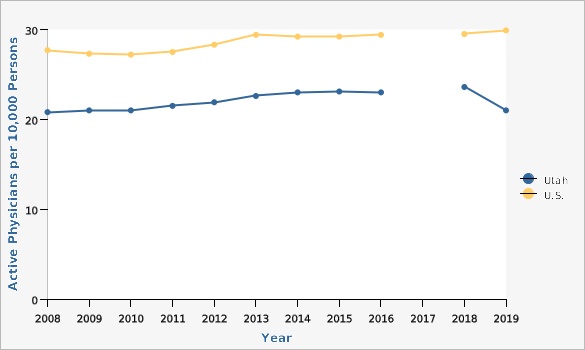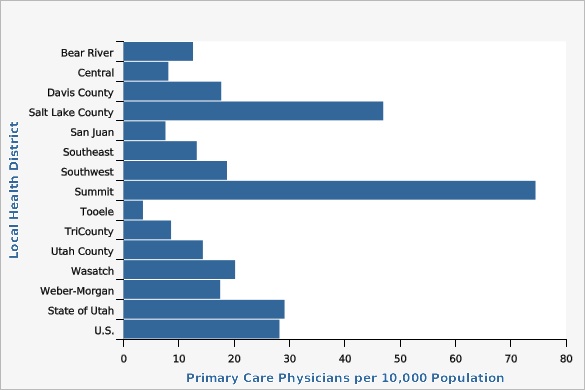Complete Health Indicator Report of Physician Supply
Definition
This indicator report includes physicians per 10,000 civilian population.[[br]]Numerator
1) Number of physicians.[[br]] 2) All physiciansDenominator
Civilian population.Data Interpretation Issues
Active physicians, professionally active: Data are presented for physicians currently engaged in patient care or other professional activity for a minimum of 20 hours per week. Physicians with unknown addresses or unknown type of practice or present employment are excluded. All physicians: Includes M.D. with active or inactive status, classified or not classified status, and employed by federal government or non-federal industry. Inactive Status includes physicians who are retired, semiretired, working part time, temporarily not in practice, or not active for other reasons and indicated they worked 20 hours or less per week. Not Classified Status includes physicians who did not provide information on their type of practice or their present employment. Federal Status is defined as full time employment by the federal government, including the Army, Navy, Air Force, Veteran's Administration, the Public Health Service and other federally funded agencies. M.D. Data are included for Guam, Puerto Rico and the U.S. Virgin IslandsWhy Is This Important?
The ratio of physicians to persons in a population is an indication of the adequacy of the health system and the access to care for persons in that population.How Are We Doing?
In 2022/2023, the ratio of primary care physicians to population varied between the 13 local health districts (LHDs) in Utah from 74.49 per 10,000 in Summit County Health District to 3.52 in Tooele County Health District. This ratio varied among the 29 counties in Utah from 74.49 per 10,000 people in Summit County to 0 in Daggett County. It must be kept in mind that primary care physicians are classified by county, but physicians who practice in multiple locations may see patients who reside in surrounding counties.How Do We Compare With the U.S.?
The ratio of active physicians to persons in the Utah population has been lower than the U.S. ratio for all years reported. In 2019, there were 29.9 active physicians per 10,000 population in the U.S. compared to 21.0 per 10,000 in Utah.What Is Being Done?
he Office of Primary Care and Rural Health (PCRH) works to improve access to quality primary, behavioral, and oral healthcare in rural and underserved communities. PCRH is an office of the Utah Department of Health and Human Services and receives funding from federal grants and state appropriations. For more information, visit [https://ruralhealth.utah.gov/].Available Services
Office of Primary Care and Rural Health[[br]] Utah Department of Health and Human Services[[br]] Multi-Agency State Office Building[[br]] 195 North 1950 West[[br]] Salt Lake City, Utah 84116[[br]] Web: [https://ruralhealth.utah.gov/][[br]] Phone: (801) 201-9462[[br]] Email: opcrh@utah.govRelated Indicators
Relevant Population Characteristics
The need for medical services is dependent on the age of the population. The fact that the Utah population is growing older and people are living longer will affect the need for health care services as people live longer and with one or more chronic conditions.Related Relevant Population Characteristics Indicators:
Health Care System Factors
The Utah Health Care Workforce Financial Assistance Program has successfully assisted in retaining health care professionals serving rural and underserved populations in Utah through providing educational loan repayment.Health Status Outcomes
People who are unable to obtain timely primary medical care, especially if they have an existing chronic health condition, may require hospital care that could have been avoided.Graphical Data Views
Active Physicians per 10,000 Civilian Population, Utah and U.S., 2008-2019

The ratio of active physicians to persons in the Utah population has been lower than the U.S. ratio for all years reported.
| Utah vs. U.S. | Year | Active Physicians per 10,000 Persons | ||||
|---|---|---|---|---|---|---|
Record Count: 24 | ||||||
| Utah | 2008 | 20.8 | ||||
| Utah | 2009 | 21.0 | ||||
| Utah | 2010 | 21.0 | ||||
| Utah | 2011 | 21.5 | ||||
| Utah | 2012 | 21.9 | ||||
| Utah | 2013 | 22.6 | ||||
| Utah | 2014 | 23.0 | ||||
| Utah | 2015 | 23.1 | ||||
| Utah | 2016 | 23.0 | ||||
| Utah | 2017 | ** | ||||
| Utah | 2018 | 23.6 | ||||
| Utah | 2019 | 21.0 | ||||
| U.S. | 2008 | 27.7 | ||||
| U.S. | 2009 | 27.3 | ||||
| U.S. | 2010 | 27.2 | ||||
| U.S. | 2011 | 27.5 | ||||
| U.S. | 2012 | 28.3 | ||||
| U.S. | 2013 | 29.4 | ||||
| U.S. | 2014 | 29.2 | ||||
| U.S. | 2015 | 29.2 | ||||
| U.S. | 2016 | 29.4 | ||||
| U.S. | 2017 | ** | ||||
| U.S. | 2018 | 29.5 | ||||
| U.S. | 2019 | 29.9 | ||||
Data Notes
Active physicians [https://www.cdc.gov/nchs/hus/report.htm][[br]] All physicians [https://data.hrsa.gov/topics/health-workforce/ahrf]. [[br]][[br]]Includes active doctors of medicine (MDs) and active doctors of osteopathy (DOs). Active (or professionally active) physicians are defined as those currently engaged in patient care or other professional activity for a minimum of 20 hours per week. Other professional activity includes administration, medical teaching, research, and more. **Data for 2017 is unavailable.Data Sources
- U.S. Department of Health and Human Services, Centers for Disease Control and Prevention (CDC)
- National Center for Health Statistics
Primary Care Physicians per 10,000 Population by Local Health District, Utah and U.S., 2019

| Local Health District | Primary Care Physicians per 10,000 Population | |||||
|---|---|---|---|---|---|---|
Record Count: 15 | ||||||
| Bear River | 12.57 | |||||
| Central | 8.11 | |||||
| Davis County | 17.67 | |||||
| Salt Lake County | 46.96 | |||||
| San Juan | 7.59 | |||||
| Southeast | 13.25 | |||||
| Southwest | 18.71 | |||||
| Summit | 74.49 | |||||
| Tooele | 3.52 | |||||
| TriCounty | 8.6 | |||||
| Utah County | 14.35 | |||||
| Wasatch | 20.18 | |||||
| Weber-Morgan | 17.48 | |||||
| State of Utah | 29.12 | |||||
| U.S. | 28.2 | |||||
Data Notes
Active physicians [https://www.cdc.gov/nchs/hus/report.htm][[br]] All physicians [https://data.hrsa.gov/topics/health-workforce/ahrf]. [[br]][[br]]Primary care physicians include non-federal M.D.s and D.O.s under age 75 who are not hospital residents and whose major professional activity is patient care in General Practice; General Family Medicine; General Internal Medicine; or General Pediatrics.Data Source
Area Health Resource File (AHRF), U.S. Department of Health and Human Services, Health Resources and Services AdministrationPrimary Care Physicians per 10,000 Population by County, Utah and U.S., 2019

| County | Primary Care Physicians per 10,000 Population | |||||
|---|---|---|---|---|---|---|
Record Count: 31 | ||||||
| Beaver | 12.4 | |||||
| Box Elder | 6.2 | |||||
| Cache | 15.5 | |||||
| Carbon | 10.8 | |||||
| Daggett | 0.0 | |||||
| Davis | 17.7 | |||||
| Duchesne | 12.6 | |||||
| Emery | 1.0 | |||||
| Garfield | 2.0 | |||||
| Grand | 31.0 | |||||
| Iron | 8.9 | |||||
| Juab | 8.2 | |||||
| Kane | 5.0 | |||||
| Millard | 7.6 | |||||
| Morgan | 31.6 | |||||
| Piute | 6.7 | |||||
| Rich | 3.8 | |||||
| Salt Lake | 47.0 | |||||
| San Juan | 7.6 | |||||
| Sanpete | 8.6 | |||||
| Sevier | 7.8 | |||||
| Summit | 74.5 | |||||
| Tooele | 3.5 | |||||
| Uintah | 6.6 | |||||
| Utah | 14.4 | |||||
| Wasatch | 20.2 | |||||
| Washington | 23.2 | |||||
| Wayne | 7.8 | |||||
| Weber | 16.8 | |||||
| State | 27.1 | |||||
| U.S. | 28.2 | |||||
Data Notes
Active physicians [https://www.cdc.gov/nchs/hus/report.htm][[br]] All physicians [https://data.hrsa.gov/topics/health-workforce/ahrf]. [[br]][[br]]Primary care physicians include non-federal M.D.s and D.O.s under age 75 who are not hospital residents and whose major professional activity is patient care in General Practice; General Family Medicine; General Internal Medicine; or General Pediatrics.Data Source
Area Health Resource File (AHRF), U.S. Department of Health and Human Services, Health Resources and Services AdministrationReferences and Community Resources
Health, United States: 2020-21 [[br]][https://www.cdc.gov/nchs/hus/report.htm] Area Health Resource Files[[br]] [https://data.hrsa.gov/data/download]More Resources and Links
Evidence-based community health improvement ideas and interventions may be found at the following sites:- Centers for Disease Control and Prevention (CDC) WONDER Database, a system for disseminating public health data and information.
- United States Census Bureau data dashboard.
- Utah healthy Places Index, evidence-based and peer-reviewed tool, supports efforts to prioritize equitable community investments, develop critical programs and policies across the state, and much more.
- County Health Rankings
- Kaiser Family Foundation's StateHealthFacts.org
- Medical literature can be queried at PubMed library.
Page Content Updated On 04/05/2024,
Published on 05/07/2024
